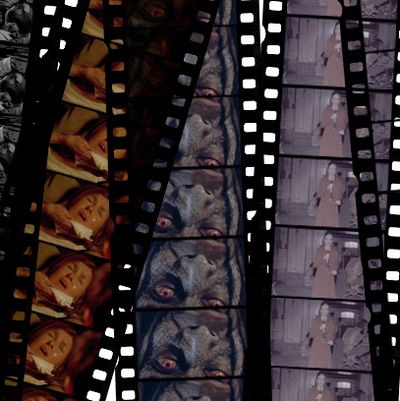
It’s not enough to hold up a camera and let American Horror Story’s formidable repertory devour scenery. Filming Ryan Murphy’s homage to all things twisted and frightening requires showmanship, a sort of funhouse mirror sensibility, and, most important, an unapologetic love of pastiche. The show marks the second collaboration, after Glee, between Murphy and cinematographer Michael Goi (they also paired up for the short-lived NBC comedy The New Normal), and it’s one that allows Goi to sample from much of the art that inspires him. On the occasion of tonight’s third-season finale, we asked the cinematographer to run through how he pulled off ten of the FX anthology series’s most striking images and moments.
Vivien delivers a monster — “Birth” (Season 1, Episode 11)
The doozy of a birthing scene from the first season’s penultimate episode is a mash-up of disparate perspectives: Vivien’s bleary-eyed delivery, and husband Ben’s panic and confusion. (Yes, Ben! Your house is haunted!) To get the shots, Goi used specialized lenses, subjective moody lighting, and queasy camera movements to delineate between the two. After watching Connie Britton rehearse the scene a few times, he chose to light her in warm, fiery-red tones. “The way she was playing it,” says Goi, “it was like she was getting submerged by these fever dreams rather than just screaming in agony.” Ben, meanwhile, is caught in a Rosemary’s Baby–esque den of evil. “He’s relying on all these ghosts to help save his wife’s life,” says Goi, “and his daughter just told him she’s dead. You see him have these little mind collapses, which we did as flashes of him screaming in the corner. The key was to making sure it all played cohesively in this vortex of mind-sucking evil into which this family is descending.”
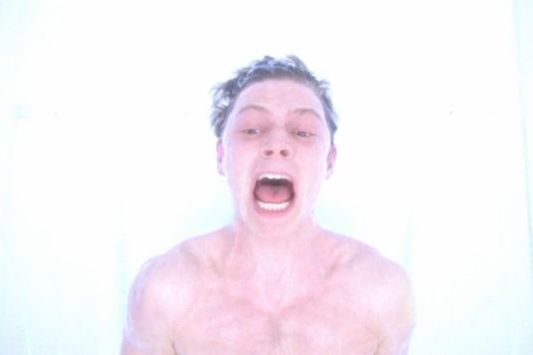
Kit’s alien invasion — “Welcome to Briarcliff” (Season 2, Episode 1)
“It looks like the white is sucking Kit in, and that’s exactly the feeling we wanted to have, like you can’t escape from it,” explains Goi of the screengrab above, depicting the Evan Peters character’s blinding alien terror. The show’s art department built translucent tables outfitted with neon lights for Peters to lay on, and Goi amped things up by overexposing the film six stops. The white started to bleed around Kit and the alien arms, and Goi added in white super-frost diffusion filters to take the effect even further. “They were popular in the seventies, but no one uses them anymore,” he says. “They really blow out the white. Then we shot reflections in Mylar material and wiggled our fingers on the back of it to make the aliens look even creepier,” Goi laughs. “These are all silent-movie techniques. You can do them in your backyard.”
Sister Jude visits a Nazi hunter — “I Am Anne Frank Part II” (Season 2, Episode 5)
Goi received an Emmy nomination for his cinematography work on this episode, which opens with a three-minute uninterrupted shot of Sister Jude visiting a Nazi hunter who she believes can provide her with dirt on a colleague at Briarcliff. A single camera prowls around the room, weaving between the conversation and the Nazi artifacts. “You get the sense of the uneasiness Jude feels as she, and the camera, absorb the photos and newspaper clippings the guy’s got lying around,” Goi says. He used just two lights to illuminate the clandestine meeting (and to stay out of the roving camera’s path).
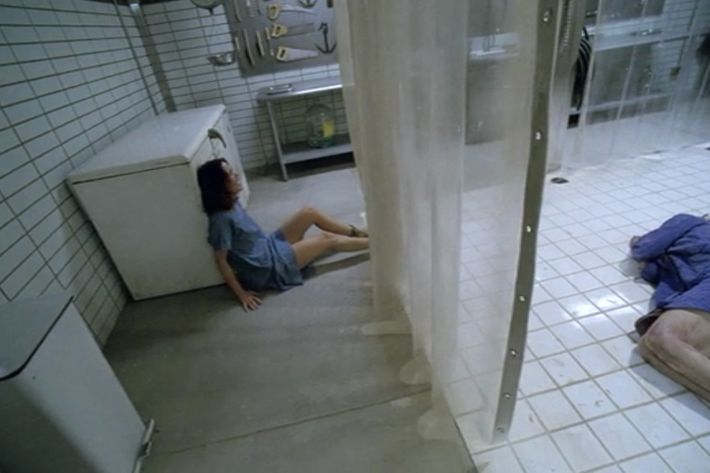
Lana discovers the identity of Bloody Face — “I Am Anne Frank Part II” (Season 2, Episode 5)
In one of Aslyum’s most disturbing sequences, Lana arrives at Dr. Thredson’s home where she makes the terrible discovery that he is the serial killer Bloody Face. The action moves from his warmly lit living room to his hidden workshop, which has been cast in a jaundice yellow, and then on to his extra-bright basement lair. “We wanted to go from the surface gentility of this carefully cultured, mannered guy, to having the warts start to show,” says Goi. (Insert creepy shots of the nippled lamp shade, and the skull candy dish.) Lana’s slow realization builds to an operatic climax with the reveal of Thredson’s basement, which the script described simply as “the creepiest place you’d ever want to find yourself.” For Goi, that meant lots and lots of light. “Thredson’s a surgeon. He fancies himself a medical wonderboy,” he notes. “So we have shots of gleaming tools and plastic. Lana’s fear comes from a lack of control, like when you go to the dentist and they begin drilling. That environment is brightly lit with fluorescent lights. They have white walls and shiny chrome. I wanted it to feel like she was going to the worst dentist in the world.”
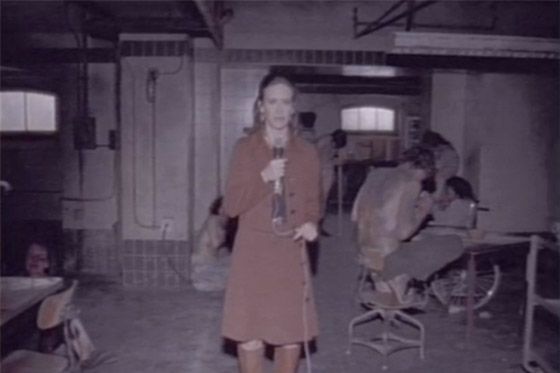
Lana’s Briarcliff documentary — “Madness Ends” (Season 2, Episode 13)
In constructing season two, Murphy took inspiration from Geraldo Rivera’s 1972 exposé Willowbrook: The Last Great Disgrace, about the deplorable conditions found in a state-run institution for mentally disabled children. He wanted Lana to make a similarly affecting documentary about Briarcliff. “I realized that what Ryan was reacting to was not only the grimness of the subject matter, but the fact that he had seen it on a bad video dupe copy,” recalls Goi. To mimic the effect, he shot Lana’s documentary on 16mm film and had his postproduction team transfer it to 3/4 U-matic video tape, an industrial format no longer used. “That gave it the distressed, decaying look that made Lana’s footage feel more horrific and like it was shot in the seventies,” he says.
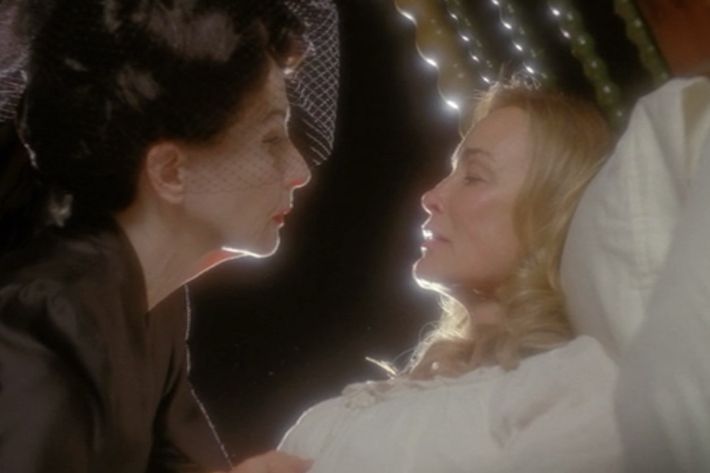
Jude’s death — “Madness Ends” (Season 2, Episode 13)
Both Murphy and Goi share a love of Bob Fosse’s All That Jazz, and when it came time to film Jude’s last breath, Goi wanted to replicate Joe Gideon’s final acceptance of death. “I had been thinking about how Jessica Lange portrayed the Angel of Death in that movie,” he says, “and I remember how Roy Scheider kind of floated, almost on a dolly, toward her, ostensibly to get the kiss of death.” The visual metaphor was dramatic. “We made the room this massive black void, isolating Jude and the Angel, and I think that made it a great deal more emotional than it would have been if Jude had just been kissed in daylight in the room,” Goi says.
The history of the Salem witches — “Bitchcraft” (Season 3, Episode 1)
The Seven Wonders demonstration — “Go to Hell” (Season 3, Episode 12)
Zoe narrates a history of the Salem Witch Trials, revealing that the smart witches didn’t burn, they escaped to New Orleans — which plays out on an accompanying old-time newsreel. Goi says that, during a scouting trip, he and episode director Alfonso Gomez-Rejon came across a display of a vintage magic lantern projector, which used glass slides to project images. “In my mind,” says Goi, “that evolved into, Well, maybe the historical scenes should be a reflection of the birth of cinema.” To make the footage feel like a real newsreel, Goi shot on 16mm black-and-white film with heavy diffusion filters and a hand-crank on the camera.
When he was asked to repeat the process he used in “Bitchcraft” to depict the witches from generations past performing the Seven Wonders, Goi used the opportunity to tip his hat to George Melies’s A Trip to the Moon. “We included the phases of the moon in the background,” he says. “There was a playfulness to those old filmmaking techniques, and I thought it would be cool to rig a moon on a see-saw and have it go up and down like it would have back then.”
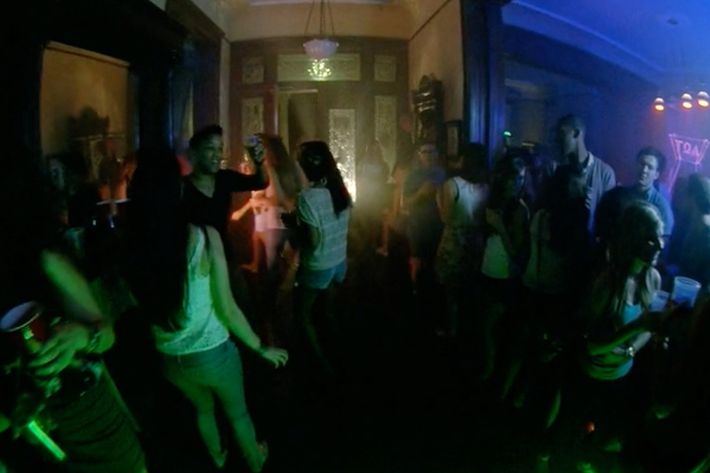
Madison takes Zoe to a frat party — “Bitchcraft” (Season 3, Episode 1)
The lurid portraits of Larry Clark and Nan Goldin inspired the raw intensity and saturated colors of the party Madison and Zoe attend in Coven’s premiere episode. “The work of Nan Goldin in particular is real and hyperreal at the same time,” Goi says. “It gives you the feeling like you’re immersed in this world that’s not the real world, but at the same time is a reflection of how things at their worst could be.” Using a hard light on Madison, a Hollywood actress not unlike Lindsay Lohan, made Emma Roberts stand out among the local kids. “Everything in that party should feel realistic — not too Hollywood, not too clean — but it should look like Madison stepped out of a tabloid,” says Goi.
The introduction of Axeman — “The Axeman Cometh” (Season 3, Episode 6)
“The shadows here cut through almost like razor blades,” Goi says. He hoped to match the visual aesthetic of Fitz Lang’s M and that period of late-twenties German photography to set the stage for the entrance of the Axeman, the killer and jazz aficionado who terrorized New Orleans from 1918 to 1919. “The oblique angles, especially in the city scenes toward the end of the film, and the use of really long shadows, I thought would be the perfect way to introduce this smooth killer,” Goi says, explaining that, to create the huge contrasts, he lit the character’s entrance as though the scene were being filmed in black-and-white (it wasn’t). “It gave me those silhouettes and those shadows obscuring his face and falling off into a gray dirge.”
Fiona summons Papa Legba — “The Magical Delights of Stevie Nicks” (Season 3, Episode 10)
On the flipside of the Axeman, Coven’s coke-snorting Voodoo crossroads demon Papa Legba had to be shrouded in shadows that were sneaky and fluid. To create them, Goi fixed grates to skateboards and had grips roll them back and forth in front of lit fireplaces. The effect: dancing demon shadows on the wall. Then there were the acrobatic camera swoops. “We did these 180- and 200- and 360-degree moves, just to make it feel like you were in this netherworld where Papa Legba negotiates,” Goi says. “I especially liked the shot of Fiona doing cocaine. The camera tilts down 100 degrees and then swoops back up and goes all the way around to land on Papa Legba’s evil red eyes.”




